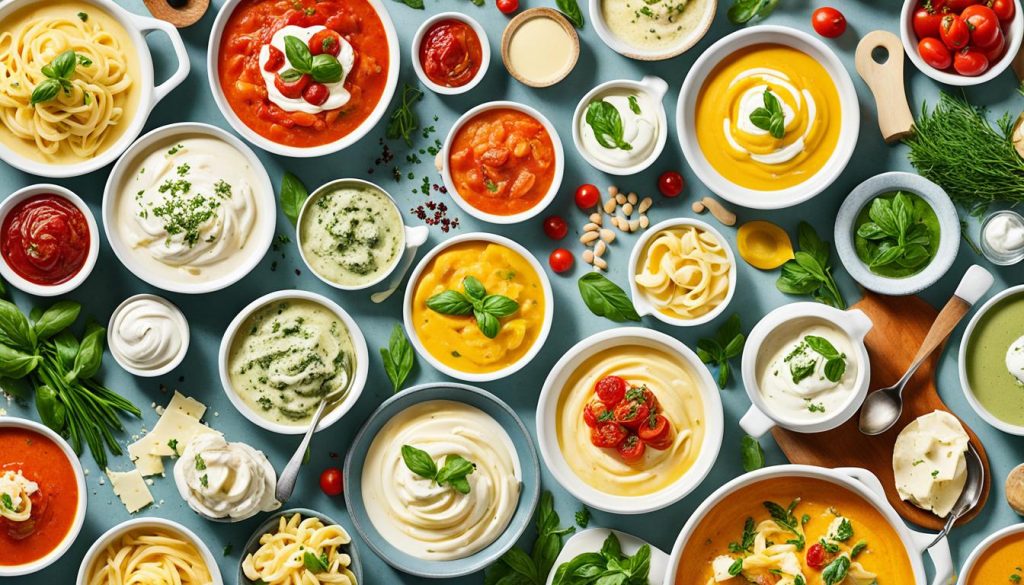Delve into the sumptuous world of culinary secrets and discover how cooking cream can transform the simplest of ingredients into a masterpiece of flavor and texture. As a cornerstone within the kitchen, cooking cream serves as an indispensable ally to both novice and professional chefs aiming to unlock the depth and richness in a variety of dishes. Let’s explore the qualities that make cooking cream a true game-changer in elevating enhance flavors to new heights.
Key Takeaways
- Understand the unique ability of cooking cream to prevent curdling when exposed to heat.
- Learn about the culinary versatility of cooking cream and how it can be used in different recipes.
- Appreciate the smooth texture and richness that cooking cream adds to dishes.
- Compare cooking cream with other cream varieties to choose the best option for your cooking needs.
- Unlock the potential of cooking cream to create dishes that are as rich in flavor as they are in appearance.
Understanding Cooking Cream and its Unique Properties
The realm of culinary arts constantly evolves with the introduction of ingredients like cooking cream that boast unique properties essential for today’s versatile kitchen. As a staple component known for its ability to prevent curdling, cooking cream brings culinary versatility to the table, becoming the chef’s go-to for a myriad of uses in recipes. Here, we shall delve into its characteristics and how they stand in comparison with other cream varieties.
Designed for Heat: How Cooking Cream Prevents Curdling
Confronted with the heat of the kitchen, cooking cream maintains its composure where other dairy may falter. The secret lies in its specialty formulation designed to withstand higher cooking temperatures, elegantly avoiding the common pitfall of separation. As it retains its creamy consistency, it becomes a critical ingredient for chefs aiming for impeccable texture and stability in their heated concoctions.
Culinary Versatility: Ideal Uses for Cooking Cream in Recipes
One cannot overstate the culinary versatility of cooking cream. Whether it’s enriching the creamy zest of alfredo sauce or being the silken touch in velvety custards, cooking cream serves as a foundational element across an array of dishes that span from savory stews to sweet endings. Below is a list highlighting its remarkable uses:
- Enhancing pasta sauces with a luxurious creaminess.
- Creating a rich base for sumptuous soups and stews.
- Adding depth to the flavors of curries and casseroles.
- Infusing baked goods with moisture and fine texture.
Comparing Cooking Cream to Other Cream Varieties
Culinary professionals and home cooks alike benefit from understanding how cooking cream measures up against its counterparts. Its rapid thickening ability and heat resilience are particularly noteworthy. To illuminate these contrasts, consider the following comparison table:
| Cream Variety | Characteristic | Heat Resistance | Thickening Ability |
|---|---|---|---|
| Cooking Cream | High fat, no added thickeners | Excellent | High |
| Heavy Cream | High fat, whippable | Good | Medium |
| Half and Half | Lower fat, more liquid | Poor | Low |
| Sour Cream | Cultured, tangy flavor | Moderate | Medium |
In this focused exploration of cooking cream, its robustness in the face of heat and flexibility shines, making it an indispensable ingredient for those who pursue excellence in culinary endeavors. Through this analysis, the superiority of cooking cream in creating sumptuous, hearty dishes that satisfy the palate becomes clear.
What is Cooking Cream
In the realm of culinary arts, cooking cream serves as a cornerstone ingredient that dramatically enhances the quality and flavor of a dish. Distinct in its composition, cooking cream is superbly designed to merge seamlessly into the culinary canvas, offering chefs and home cooks alike the ability to unlock the full potential of their recipes. This type of cream is praised for its special formulation that combats the common kitchen woe of curdling – a quality that sets it apart from regular creams and makes it indispensable in the high-heat environments of cooking.
Designed for Heat: How Cooking Cream Prevents Curdling
Its unique properties empower cooking cream to resist the high temperatures that typically cause dairy products to separate. The science behind this phenomenon lies in its careful processing, which ensures that it maintains a stable, smooth consistency; this is why it is the preferred choice for professionals looking to avoid the curdling that can deflate the appeal of their culinary creations. The heat resilience of cooking cream elevates it beyond its peers, ensuring that its rich texture is ever-present, from the sauté pan to the serving plate.
Culinary Versatility: Ideal Uses for Cooking Cream in Recipes
The uses of cooking cream are myriad and diverse, with its swift thickening capabilities playing a pivotal role in a variety of dishes. From the sumptuous layers in casseroles to the velvety sauces of pasta creations, and from the rich bases of custards to the delicate moistness in baked desserts, cooking cream consistently delivers. Its adaptability is evident in both sweet and savory contexts, manifesting as an infusion of creaminess that enriches and deepens existing flavor profiles, echoing the definition of true culinary versatility.
Comparing Cooking Cream to Other Cream Varieties
A comparison with other cream varieties illuminates the distinctive traits of cooking cream. While thickened cream relies on additional agents to achieve a denser texture, cooking cream inherently possesses a richness that negates the need for such additives, offering a more natural taste. Its rapid thickening property and substantial heat tolerance not only distinguish it from other creams but also earn it a spot as a cooking staple capable of supplanting them in almost any culinary challenge that calls for creamy indulgence.


